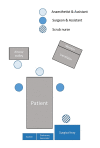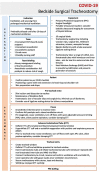Bedside open tracheostomy in COVID-19 patients - a safe and swift approach
- PMID: 37992143
- PMCID: PMC11175577
- DOI: 10.4317/medoral.26326
Bedside open tracheostomy in COVID-19 patients - a safe and swift approach
Abstract
Background: Tracheostomy can be performed as an open surgical procedure, percutaneous, or hybrid and forms an important step in the management of patients infected with coronavirus disease 2019 (COVID-19) requiring weaning from mechanical ventilation. The purpose of this article is to share our experience to performing bedside surgical tracheostomy in COVID-19 patients in a safe and effective manner, whilst minimising the risk of viral transmission, to optimise patient outcomes and reduce risk to healthcare professionals.
Material and methods: As recommended by ENT UK, we prospectively established a COVID Airway Team within the ENT department at Birmingham Heartlands Hospital, consisting of four head and neck consultant surgeons to perform either open-bedside, open-theatre or percutaneous tracheostomy in COVID-19 patients. A specific stepwise method for bedside open surgical tracheostomy was based on ENT UK and British Laryngological Society recommendations.
Results: Thirty patients underwent tracheostomy during the study period (14 bedside-open, 5 open-theatre, 11 percutaneous). Mean duration of mechanical intubation prior to bedside-open tracheostomy was 14.5 days. The average time for open-bedside tracheostomy was 9 minutes compared to 31 minutes for open-theatre. There were no significant tracheostomy related complications with bedside-open tracheostomy. No healthcare professional involved reported acute COVID-19 infection.
Conclusions: We describe our effective, safe and swift approach to bedside open tracheostomy during the COVID-19 pandemic. Our experience demonstrated a short mean procedural time, with no tracheostomy-related complications and no reported viral transmission amongst the healthcare members involved.
Conflict of interest statement
The authors declare no conflict of interest, financial or otherwise.
Figures


Similar articles
-
Percutaneous and Open Tracheostomy in Patients with COVID-19: Comparison and Outcomes of an Institutional Series in New York City.Ann Surg. 2021 Mar 1;273(3):403-409. doi: 10.1097/SLA.0000000000004428. Ann Surg. 2021. PMID: 32889885
-
Healthcare Personnel Safety During Percutaneous Tracheostomy in Patients With COVID-19: Proof-of-Concept Study.J Intensive Care Med. 2021 May;36(5):612-616. doi: 10.1177/0885066620980384. Epub 2020 Dec 16. J Intensive Care Med. 2021. PMID: 33323033
-
Percutaneous dilatational tracheostomy for saturating influx of COVID-19 patients: Experience of military ENT physicians deployed in Mulhouse, France.Eur Ann Otorhinolaryngol Head Neck Dis. 2020 Sep;137(4):263-268. doi: 10.1016/j.anorl.2020.06.016. Epub 2020 Jun 28. Eur Ann Otorhinolaryngol Head Neck Dis. 2020. PMID: 32631724 Free PMC article.
-
Utility of Tracheostomy in Patients With COVID-19 and Other Special Considerations.Laryngoscope. 2020 Nov;130(11):2546-2549. doi: 10.1002/lary.28734. Epub 2020 May 12. Laryngoscope. 2020. PMID: 32368799 Free PMC article. Review.
-
Recommendation of a practical guideline for safe tracheostomy during the COVID-19 pandemic.Eur Arch Otorhinolaryngol. 2020 Aug;277(8):2173-2184. doi: 10.1007/s00405-020-05993-x. Epub 2020 Apr 21. Eur Arch Otorhinolaryngol. 2020. PMID: 32314050 Free PMC article. Review.
References
MeSH terms
LinkOut - more resources
Full Text Sources
Medical
Research Materials
Miscellaneous

